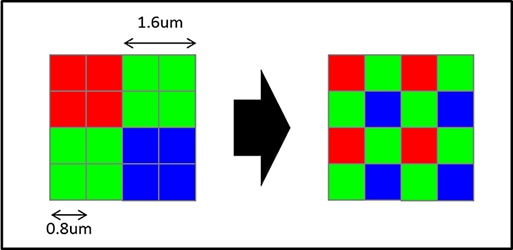48 megapixel for smartphone

Comparison of a conventional image with a resolution of 12 megapixels (left) and a frame taken from a new IMX586 sensor with a resolution of 48 megapixels (right)
Sony introduced the IMX586 , the world's first CMOS sensor for smartphones with an effective resolution of 48 million pixels. This means that the sensor will be able to capture frames of 8000 × 6000 pixels without software interpolation! Previously, this size was available only on expensive professional cameras, and not at all.
Well, shooting a video with a modest 4K resolution (4096 × 2160) for such a sensor is easier than ever. He does this at 90 frames per second.
Sensor specifications are quite impressive. Apparently, the cameras with 48 megapixels will very soon become the main asset of top smartphones. The company promises to start mass deliveries of IMX586 already in September 2018.
')
How did Sony achieve such a dramatic increase in resolution? Well, there were some tricks here. IMX586 combines two key technologies:
- Very small size of light-sensitive elements (very high resolution)
- Signal processing with Quad Bayer color filter with multiple algorithms to increase resolution

Conceptual diagram of the pixel grid of the new sensor (Quad Bayer Array) and its transformation scheme using the original signal processing algorithm (right)
The physical size of the sensor is 1/2 "or 6.4 × 4.8 mm. This is a large size - the largest one that is put on smartphones, with rare exceptions . Usually, phones use 1/3" format sensors, that is, almost twice smaller size. But you can't fit 48 megapixels in 1/3 ", but with a 1/2" format, this trick turned out.
If you count on the calculator, then you can estimate the physical size of each of the 48 million photosensitive elements on the sensor 6.4 × 4.8 mm. Pixels with a side of about 0.8 microns are obtained.
Now about the original color filter Quad Bayer. His work is shown in the diagram above. It works so that each block of 2 × 2 pixels has the same color filter. This allows you to process data differently, depending on conditions.
In low light conditions, data from four photocells is combined - and they actually work as a single element with a side size of 1.6 µm. In this case, the resolution of the sensor is reduced four times and it “turns” into a standard sensor of 12 megapixels, only probably with a lower level of thermal noise.
Well, in conditions of good lighting, when thermal noise is invisible, and photon energy is more than enough, the sensor works in full force, each photocell independently of the others captures the signal - and the result is the quality, which is shown in Sony's CDPC. But this is still not quite honest 48 million pixels, but some kind of approach to them after digital signal processing. It will be very interesting to see how this sensor actually works and how noticeable is the difference between frames of 12 and 48 MP in reality. If everything works as promised, then such a smartphone can be used as a kind of "binoculars" - do not take pictures, but repeatedly zoom in on the screen to see the details of distant objects that are invisible to the eye.
In its press release, Sony says that the new sensor has a four-fold dynamic range than conventional sensors. According to experts , the same system is used here as in the IMX294 sensor, where part of the pixels work with incomplete exposure, protecting themselves from glare, but at the same time recording details in the shadows. At least the Quad Bayer filter structure is well suited for this method of operation.
It turns out that the sensor works in three modes: low illumination (12 MP),
High resolution (48 MP) or increased dynamic range in high contrast scenes. This is an interesting approach that somewhat resembles Fujifilm Super CCD EXR technology.
Most likely, the new sensor will first see the light in the Sony smartphone, and then in the smartphones of other manufacturers. It is highly likely to be placed on the Sony Xperia XZ3, scheduled for release in September.
Source: https://habr.com/ru/post/418239/
All Articles